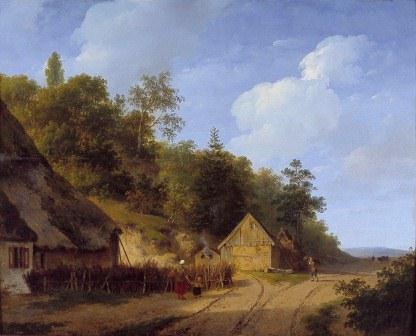This case concerned an application for restitution of the following four paintings from the Dutch National Art Collection:
The claim was based on a postcard sent from Westerbork concentration camp, which came into the hands of the applicant fifty years after it had been sent. On this postcard, which was addressed to the applicant’s mother, the writer expresses his wish to make a gift of five paintings to the applicant. This postcard, which is dated 2 July 1942, reads as follows:
The applicant, who was born on 5 September 1929, saw the card for the first time at the end of August 2002 during a visit to his seriously ill mother. She told him that she had gone to the address indicated on the postcard around August 1942 to collect the paintings but the house had already been looted. She also confirmed that day that V., a Jewish art dealer, was the applicant’s natural father. As a child, the applicant had visited his father a few times before the war and he had precious memories of those visits. The postcard prompted the applicant to look more deeply into the events surrounding his father’s art collection during the Second World War.
In this case the Restitutions Committee was confronted with various questions. In the first place, it was necessary to find out whether the four works from the NK collection that were the subject of the application for restitution were the paintings that had been removed from V.’s house in the summer of 1942. An (art) historical investigation carried out by BHG showed that three of the four NK works had appeared on the Amsterdam art market shortly after the arrest of the applicant’s father in the summer of 1942: Cottages on the edge of a wood (NK 2394), Landscape with water mill and peasants driving cattle along a sandy road (NK 2389) and Winter landscape with deer (NK 2526). The investigation provided no clear answer to the question as to the location of the paintings before then. Given this gap in the provenance history, it is possible that the paintings in question were in the possession of the applicant’s father until 1942. Given the rarity of exhibitions of the oeuvre of the artists concerned, BHG concluded that such a provenance was very probable for numbers NK 2389 (Koekkoek) and NK 2626 (Van Os) and certainly very possible for number NK 2394 (Schelfhout). However, as regards the fourth painting, Italian landscape in the evening (NK 3027), it was not possible to determine when it appeared on the art market and whether this appearance was before or after the applicant’s father was arrested. BHG concluded in respect of this painting, based on the existing documentation (i.e. the description of the work on the postcard and the oeuvre of the artist in question), that it was not possible to make any statement about its identity.
In order to assess whether the gift could be contested under inheritance law, the Committee investigated whether there were any forced heirs when V.’s estate was divided up, V. having been murdered in Auschwitz shortly after he was arrested. Among other places, this investigation led the Committee to notarial archives in Switzerland where V.’s wife had lived until she died. The investigation showed that there were no forced heirs to the estate of the applicant’s father who could have contested the gift on the grounds of infringement of their forced share.
In its advice, it was the Committee’s judgement in respect of the painting Italian landscape in the evening (NK 3027) that there was insufficient evidence to make it highly likely that this was the painting owned by the applicant’s father and described on the postcard as Italian Mountains by Govaerts. The Restitutions Committee therefore advised rejecting the application for restitution of NK 3027.
